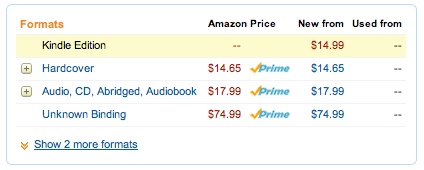A while back I was talking about how great it was to see music artists like Sam Phillips turn the old system upside down and not only publish her own digital music, but also bring her fans behind the curtain while she made it.
It seems the same thing has been happening in book publishing.
I was checking my local library queue the other night and saw that I was number 277 in line to borrow the new book from Michael Connelly.
I didn’t feel like waiting that long, knew I had some credit at Amazon and figured I’d just download it to my Kindle app. Live a little. Splurge.
I learned two things: 1) The book’s not released yet and 2) We live in times where an actual physical object, made of materials and labor, delivered to my doorstep, costs less than a tiny cupful of data, delivered wirelessly.
That’s right. The Kindle version of the new Michael Connelly novel costs more than the new hardcover:
But that’s not really the point of this post. The point of this post is that my thwarted intention to buy the new Michael Connelly — and my recoil at the price — led me to glance across the screen to the chart of top mystery books where the latest by Stephen Carpenter — a pixel-turner called “Killer” — was on offer for the remarkably reasonable sum of $2.99.
How can you not take a chance on a book for three bucks?
As it turned out, money well-spent. The guy can write. I’m looking forward to finishing it later tonight.
And that is the point of this post. That Carpenter is not alone. That readers can be found outside the traditional channels. Check out all those titles at the top of the Kindle charts with the tiny prices: In the publishing business, right now, disintermediation happens.
Stephen Carpenter — a successful screenwriter — is now also a successful novelist thanks to his ability to publish his first book on Kindle, price it reasonably and keep many more of the dollars than if he had gone through a traditional publisher.
“I think it’s an incredible step forward for authors and readers alike. I read a columnist the other day who likened the development of the e-reader to the Gutenberg press, in terms of progressing the written word. That’s obviously an overstatement, but I think it’s great that so many people have access to so many books inexpensively–and that so many authors can publish without going through traditional channels.”
And then there’s Amanda Hocking, who has gotten a great deal of attention lately as “the most successful indie author” on Amazon. To date she’s sold 700,000 books, according to Business Insider.
She gets to keep 70% of her book sales — and she sells around 100,000 copies per month. By comparison, it’s usually thought that it takes a few tens of thousands of copies sold in the first week to be a New York Times bestselling writer.
The comparison isn’t entirely fair, because Hocking sells her books for $3, and some $.99. But that’s the point: by lowering the prices, she can make more on volume, especially impulse buys. Meanwhile e-books cost nothing to print, you don’t have to worry about print volumes, shelf space, inventory, etc. And did we mention the writer keeps 70%?
Hocking and other authors are making a tidy living publishing without publishing houses, using the massive distribution and reach of Amazon to rack up numbers that would qualify them for New York Times Bestseller status. If The New York Times didn’t ignore this category of sales, that is.
This list, for example, has almost 40 authors — most you’ve never heard of — who are selling 1,000 books a month or more through Amazon. They’re not all wearing spats and lighting stogies with $50 bills yet, but they’re reaching real readers and collecting real dollars.
What do you think? Are traditional publishers in trouble here, or is this the beginning of a glorious revolution in authoring and reading that has benefits for everyone, classy-imprint houses included? I hope it’s win-win-win, but for an industry that seems so afraid of digital that it prices downloads to prop up physical book purchases, I’m not holding my breath.




